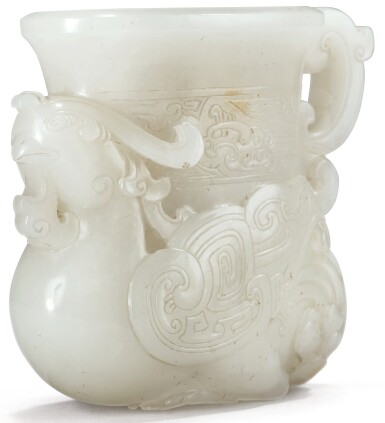
Ancienne Collection Aristocratique Française | 法國貴族舊藏
RARE ET IMPORTANTE COUPE EN JADE BLANC ET ROUILLE DYNASTIE QING, ÉPOQUE QIANLONG | 清乾隆 青白玉夔鳳紋觥 | A very rare small white and russet jade vessel in the form of a phoenix, Qing Dynasty, Qianlong period
Auction Closed
December 10, 04:02 PM GMT
Estimate
15,000 - 20,000 EUR
Lot Details
Description
Ancienne Collection Aristocratique Française
法國貴族舊藏
RARE ET IMPORTANTE COUPE EN JADE BLANC ET ROUILLE DYNASTIE QING, ÉPOQUE QIANLONG
清乾隆 青白玉夔鳳紋觥
A very rare small white and russet jade vessel in the form of a phoenix, Qing Dynasty, Qianlong period
en forme de phœnix couché sur ses deux pattes, la queue recourbée sous le corps, les ailes et la tête dressées délicatement sculptées, enserrant sur le dos une coupe aux bords légèrement évasés dotée d'une anse sinueuse et dont la panse est délicatement sculptée de motifs archaïsants, la pierre au doux poli
Largeur 10,2 cm, width 4⅛ in.
寛 10.2 公分, 4⅛英寸
Archaism in the decorative arts of later dynastic China came in many different disguises. Interest in the past influenced objects in many different materials, especially those made made in bronze and jade, two materials that were the foundations of material culture in pre-dynastic Chinese history. While some objects faithfully followed archaic forms, designs, techniques and materials, others such as this charming jade vessel, can be seen as more playful interpretations of archaic models.
Few features point to the appropriation of an archaic prototype for this vessel. With its gently flared rim tapering to a narrow body, the vessel that rises from the back of the phoenix is shaped like the upper part of a of a bronze hu. However, the handle to one side of the vessel and its slightly elongated shape point to a bronze guang. The vessel is borne on the back of a recumbent phoenix, with its head leaning against the side of the vessel and its elaborate tail offering further support. Its wings are finely carved with archaistic scrolls, a pattern that is repeated around the neck of the vessel. These archaistic motifs provide the only reference to an archaic model. It appears, as Jessica Rawson noted, 'that a considerable degree of misunderstanding was allowed, it appears deliberately, and it is likely that the importance of the actual associations of the ancient shapes was never fully appreciated', in Chinese Jade from the Neolithic to the Qing, London, 1995, p. 90. Rawson continues and notes that 'the weak links between ancient objects and their later copies and the loss, or disregard, of the proper ancient associations made a full understanding and reproduction of the past impossible. What seems to have been important in Song times and later were the ways in which the past could be used to benefit the present', ibid., p. 90.
Vessels of this fine quality were made in the Palace Workshops (Zaobanshu), established by the Kangxi emperor (1662-1722). A special jade workshop was added in the first year of the Yongzheng emperor's reign (1723-1735) to make many of the jades displayed around the palace. We may assume that this small jade phoenix vessel had an elaborately made fitted stand fashioned fashioned of precious wood, ivory or lacquer. Among the works of art illustrated on the Guwantu (Pictures of Antiquity), dated 1728, are some two hundred jades, both archaic and archaistic. Like the present vessel, the later jades found on the Guwantu show the stylish finesse and sophistication of 18th century jades, see Regina Krahl, ,Chinese Jade before Qianlong', in The Woolf Collection of Chinese Jade, London, 2013, pp. 48-59.
The present vessel is rare and only few comparable pieces of related shape are known. Among them is a phoenix-shaped rhyton with dragon handle, dated to the mid-Qing period from the Palace Museum Collection in Beijing, and illustrated in Zhongguo yuqi quanji, Vol. 6, Shijiazhuang, 1993, col. pl. 37 (Fig. 1). Another vessel of slightly different shape featuring a phoenix, also from the Palace Museum Collection, is published in Compendium of Collections in the Palace Museum, Jade, vol. 10, Qing Dynasty, Hefei, 2011, p. 116, col. pl. 84. A third piece, carved with a lozenge-shaped vessel supported by a phoenix, from the collection of Alan and Simone Hartman, is published in Robert Kleiner, Chinese Jades from the Collection of Alan and Simone Kleiner, Hong Kong, 1996, col. pl. 144.
